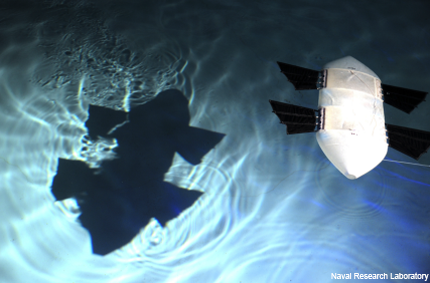The Navy's (autonomous) fish called WANDA
NRL is developing an underwater drone with pectoral fins that let it operates in crowded, near-shore environments.

WANDA'S pectoral fins are based on the reef-dwelling bird wrasse.
The Navy's development of autonomous underwater vehicles has most often taken the shape of torpedoes, producing fast, efficient devices that can travel long distances while collecting mapping data, hunting mines or performing other jobs. But the Naval Research Lab is now taking a turn toward nature, with fish-inspired vehicles designed to operate in cluttered, near-shore environments where the ability to go slow is an advantage.
NRL is developing an AUV with pectoral fins similar to those of reef fish, specifically the bird wrasse, that allow it to maneuver around obstacles and linger when necessary amid changing currents. The Wrasse-inspired Agile Near-shore Deformable-fin Automaton, or WANDA, has four curved, side-mounted fins that provide its propulsion, along with algorithms that control the fins’ movements and sensors to detect underwater obstacles, NRL said is a release.
Researchers digitally modeled the bird wrasse’s fins using fluid dynamics simulation then developed thre artificial fins that can be attached to a man-portable AUV. WANDA can swim at speeds of over two knots, or hold its position against currents of two knots, which gives it the ability to operate in harbors and other environments near a coastline. "WANDA can perform low-speed maneuvers to include forward and vertical translation and turn-in-place rotation, and we are currently evaluating station keeping in the presence of waves," said Jason Geder, an aerospace engineer in NRL’s Laboratories for Computational Physics and Fluid Dynamics at NRL.
NRL said WANDA’s modular design allows for it to be outfitted with different payloads, such as biochemical detection and target identification in shallow environments. The biochemical sensing system will be tested later this year.
The research is another example of how the Navy is getting creative with unmanned vehicles. The Chief of Naval Operations' Rapid Innovation Cell project, working with Boston Engineering, recently tested the Ghost Swimmer, an AUV that looks and swims like a tuna, which allows it to run silent (no propellers) while inspecting hulls, collecting reconnaissance or performing other tasks.
Flying Swimmer



